Pear Shaped Engagement Ring Buying Guide

Known for its teardrop-like shape, the pear-cut engagement ring is a unique symbol in itself. Diamonds come in all shapes and sizes, but the right pear shaped diamond is hard to find because they’re difficult to cut. With the right cutting techniques, you will get a diamond that has a teardrop shape with symmetrical proportions - this creates a beautiful look! In this blog post, we'll teach you how to buy a pear-shaped diamond engagement ring.
What is a pear-shaped engagement ring?
Pear-shaped diamonds are a combination of round and marquise diamonds. This teardrop shape can be worn down (towards your wrist) or facing up (towards your fingernails) allowing you to create different looks with the ring. Most people wear their pear engagement ring with the point facing towards their fingernails.
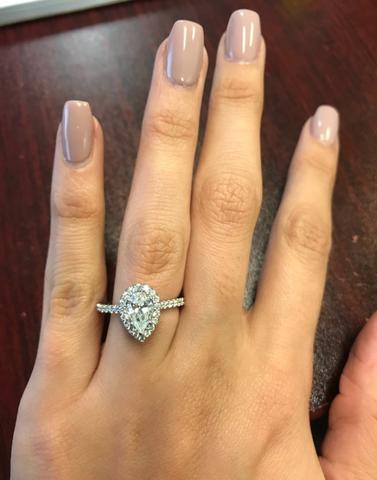 | 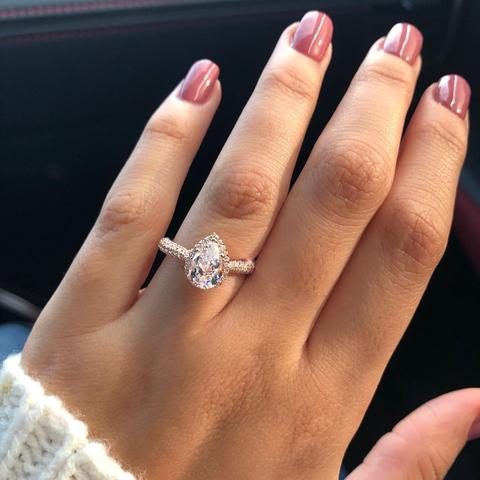 |
The pear-shaped diamond's brilliant modified cut maximizes sparkle! The 58 facets reflect the light that enters the diamond back out with lots of brilliance. Another benefit to the pear-shaped diamond is that it appears larger than diamonds of the same carat weight. It also creates a flattering, lengthening effect on the finger.
History of the pear diamond cut
The teardrop diamond, now known and loved by many, originated in Belgium back when it was still the Duchy of Burgundy. In 1458, a Flemish gemstone polisher named Louis Van Berquem (Lodewyk) created this shape with his own invention called a "scaif," which allowed him to create symmetrical diamond facets and new, more complex diamond cuts. He is also credited with the concept of absolute symmetry (meaning all of the diamond’s facets are perfectly symmetrical). Symmetry is important for all diamond cuts, but especially for pear-shaped stones - an asymmetrical pear-cut diamond will be very obvious and won’t reflect light as well.
Why are pear engagement rings so popular?
Pear-shaped stones have become increasingly more popular with couples since they stand out more than other diamond shapes. Celebrities like Ariana Grande, Cardi B, and Paris Hilton, and Kaley Cuoco have all been given pear-cut engagement rings, which has made them even more popular.
Benefits of choosing a pear engagement ring
Pear cuts are a unique shape, which makes them perfect for any occasion. Their elongated shape gives the illusion of being larger than your average round diamond - even if they are both the same carat weight! This means that you can get more bang for your buck with a pear engagement ring. Pear shapes also have the versatility to complement any style: vintage or modern; classic or chic; casual day-to-day wear...you name it!
Ideal Color Grade for a Pear-Shaped Diamond
The color you choose for your pear shaped diamond really depends on the metal that it is set in. For white gold or platinum engagement rings, you can choose a pear-cut diamond with a color of G, H, or I. These colors pair well with silver-colored metals. For rose gold and yellow gold, choose a diamond with a color of J, K, or L. The warmth of these diamonds will blend well with yellow or rose gold, and help you save money on your diamond.
Ideal Cut Grade for a Pear-Shaped Diamond
A quality cut grade ensures your stone will be full of sparkle. A well-cut diamond will also be symmetrical, and an asymmetrical pear cut diamond can be very obvious and less attractive. Always choose a Very Good cut for your pear-shaped diamond, and make sure to choose one with an Excellent symmetry grade.
Ideal Clarity Grade for a Pear-Shaped Diamond
The brilliant facet style of the pear-cut diamond will hide lots of inclusions. We recommend you choose a stone with a VS2 grade or better. Always view HD imagery and/or videos of your diamond before making a purchase! If imagery is not available, make sure to request it.
The Bowtie Effect
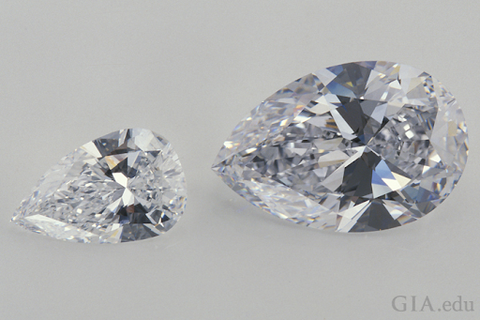
Pear cut diamonds sometimes have the bowtie effect which many find unflattering. This effect is when a dark bowtie-like shape appears across the width of the diamond. Since it creates a large black space on the stone, it reduces its sparkle and beauty. Your diamond grading report won't indicate if the stone has a bowtie, so the best way to avoid it is to view HD videos of the diamond before purchasing it.
Choosing the Right Length-to-Width Ratio
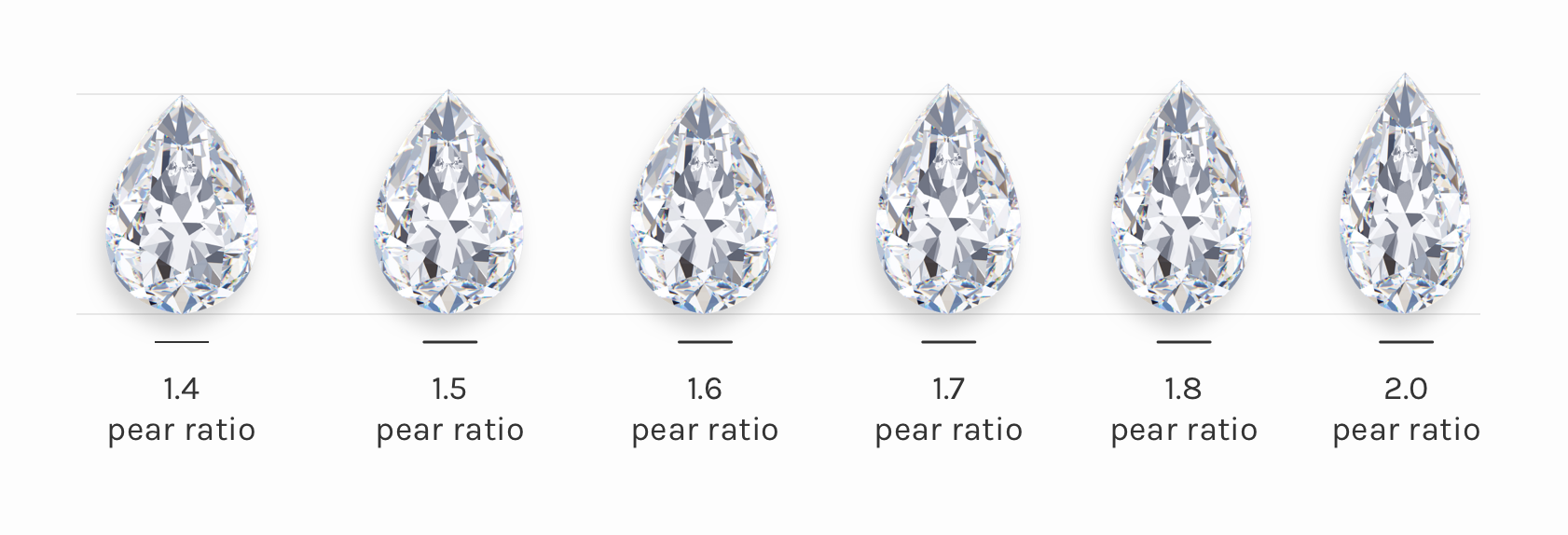
The length-to-width ratio of your pear-cut diamond will impact how wide or slender the diamond will look. The right length-to-width ratio is all about preference, but most people prefer a pear-cut diamond that has a ratio of 1.5-1.7. The length-to-width ratio is usually provided by the jeweler, but if it's not, you can calculate it by dividing the length of the diamond by its width.
Pear-cut diamond pricing
A pear-cut diamond, like other fancy shapes, is a great choice for those who want to save money on their purchase. This particular shape has a lower rough diamond waste than round cuts which means it's more affordable. A good reason why this specific type of cut can be so cost-effective is that there are fewer materials that need to go into making them; meaning that they're able to maximize what precious raw material that remains after polishing with beautiful results!
Price is relative
If you're looking for a loose pear-cut diamond, it is important to know that the quality of the stone can vary drastically and affect pricing. A 1 carat pear cut diamond can cost anywhere from $2,000 to $10,000 depending on many factors such as the stone's cut, color, and clarity grades.
How Many Prongs Should a Pear Shaped Diamond Have?
3 prongs for pear-shaped diamonds are a popular style but are not recommended. To properly secure your stone, a pear-shaped diamond should have at least 5 prongs: four prongs on the stone's sides, and one prong covering the stone's delicate point.
Pear-Shaped Engagements Rings Under $5000
Your pear engagement ring doesn't have to cost a fortune. Here are some popular settings for pear-cut diamonds.
Solitaire Diamond Gallery Engagement Ring in 14kt White Gold - $1,082 (Setting Only)
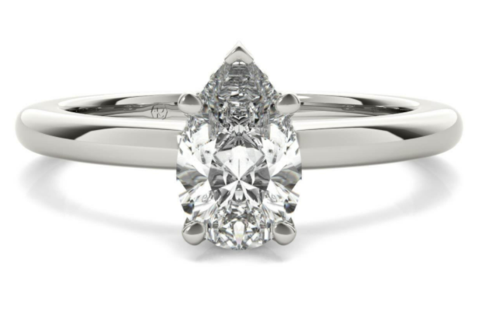
This engagement ring features a hidden halo beneath the center stone, adding a touch of artistry and sparkle. A v-shaped prong protects the point of the diamond. The benefit of its plain band is that it will pair easily with virtually any style of a wedding ring.
Three Row Pave Diamond Halo Engagement Ring in 14kt White Gold - $2,625 (Setting Only)
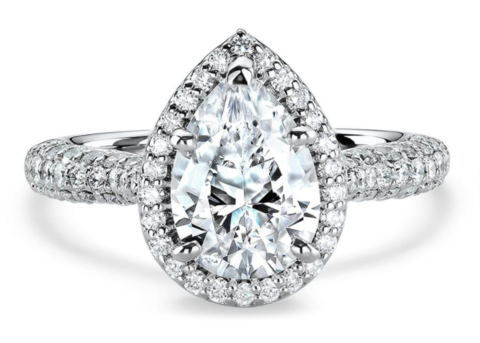
Halo engagement rings are a popular choice. They feature tiny diamonds that surround the center stone, creating the appearance of a larger diamond and creating more sparkle. The beautiful band features three rows of diamonds for sparkle at every angle.
Solitaire Diamond Knife-edge Engagement Ring in 14kt White Gold - $672 (Setting Only)

Knife-edge engagement rings are a classic choice. The unique sculpted band creates a beautiful shine that highlights the precious metal of your choice. Your pear-cut diamond will stand out in this minimal setting.
Diamond Micropavé Band Engagement Ring in 14kt White Gold - $2,751 (Setting Only)
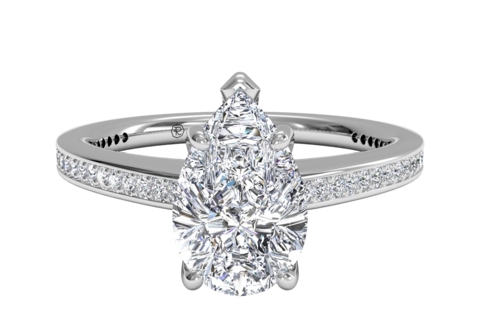
If you're looking for a pear-cut engagement ring that is simple but still has some sparkle and glamour, choose a side stone engagement ring. This engagement ring features micropavé diamonds, which makes the band appear like it is paved with diamonds.
Difference between pear engagement rings and round engagement rings
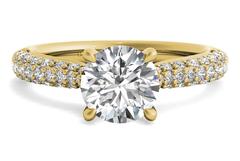
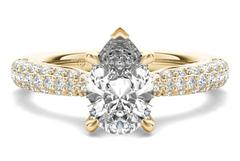
The difference between pear engagement rings and round ones is that pear-cut diamonds have a tapered point at one end. Round-brilliant diamonds are considered to be classic cuts and are far more expensive than pear-cut diamonds. They are the most popular choice for engagement rings.
How to take care of your pear cut engagement ring
The tip of the pear cut diamond is very fragile and can easily chip. Make sure to take it off when you are going to do anything strenuous with your hands. You should also be sure to have your engagement ring cleaned and inspected by a professional jeweler to make sure your ring stays sparkly and beautiful for generations. Experts recommend that you have a professional cleaning at least twice per year. At Ritani, our jewelers can thoroughly clean the diamond while examining it under magnification to ensure all prongs are secure and check for any loose stones in the band or fractures in your diamonds.
Conclusion
If you're looking for a timeless, beautiful engagement ring that will make your special someone feel loved and appreciated, then we recommend the pear cut diamond. Pear diamonds are perfect for those who want to stand out from the crowd with an elegant piece of jewelry. We hope this article has been informative and helpful in deciding what kind of engagement rings you might like to offer or wear on your big day! Contact us if you need help choosing the right ring.


